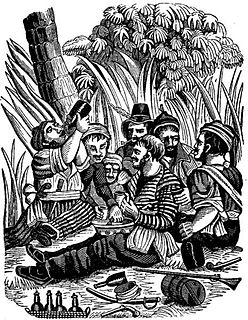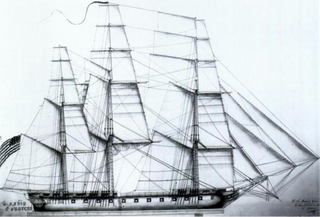 W
WPiracy was a phenomenon that was not limited to the Caribbean region. Golden Age pirates roamed off the coast of North America, Africa and the Caribbean.
 W
WAwilda, also known as Alwilda, was a female pirate. The story of Awilda is doubted by some historical scholars and considered to be a legend.
 W
WThe Battle of Cape Fear River, or the Battle of the Sandbars, was fought in September 1718 between a British naval expedition from the Province of South Carolina against the pirate ships of Stede Bonnet. British forces defeated the pirates in the Cape Fear River estuary which led to Bonnet's death by hanging in Charleston.
 W
WThe Battle of Cape Lopez was fought in early 1722 during the Golden Age of Piracy. A Royal Navy man-of-war under Captain Chaloner Ogle defeated the pirate ship of Bartholomew Roberts off the coast of Gabon, West Africa.
 W
WThe Brethren or Brethren of the Coast were a loose coalition of pirates and privateers commonly known as buccaneers and active in the seventeenth and eighteenth centuries in the Atlantic Ocean, Caribbean Sea and Gulf of Mexico.
 W
WThe Capture of the schooner Fancy was a famous British victory over two pirate ships under Captain Edward Low. When off Delaware Bay Low attacked a Royal Navy man-of-war which he mistook for a whaler. The resulting combat lasted several hours and ended with the capture of one pirate vessel. In fact, the captured vessel was not the one named Fancy - factually, the combat should have been called "Capture of the sloop Ranger."
 W
WA filibuster or freebooter, in the context of foreign policy, is someone who engages in an unauthorized military expedition into a foreign country or territory to foment or support a revolution. The term is usually used to describe United States citizens who fomented insurrections in Latin America, particularly in the mid-19th century. Filibuster expeditions have also occasionally been used as cover for government-approved deniable operations.
 W
WFort Fincastle is a fort located in the city of Nassau on the island of New Providence in The Bahamas. It was built to provide protection to Nassau.
 W
WPiracy in the Gulf of Guinea affects a number of countries in West Africa as well as the wider international community. By 2011, it had become an issue of global concern. Pirates in the Gulf of Guinea are often part of heavily armed criminal enterprises, who employ violent methods to steal oil cargo. In 2012, the International Maritime Bureau, Oceans Beyond Piracy and the Maritime Piracy Humanitarian Response Program reported that the number of vessels attacks by West African pirates had reached a world high, with 966 seafarers attacked during the year. According to the Control Risks Group, pirate attacks in the Gulf of Guinea had by mid-November 2013 maintained a steady level of around 100 attempted hijackings in the year, a close second behind Southeast Asia. Piracy in the Gulf of Guinea continues to be a concern to the shipping industry, which is affected significantly. At the same time, governments in the region generally highlight that the fight against piracy requires a broad understanding of maritime security throughout the Gulf of Guinea.
 W
WCaptain Richard Avery Hornsby ( -1819) is an almost forgotten Sunderland military figure from the 18th century. He became famous after taking on a boat full of French pirates almost single-handedly - and winning.
 W
WMadre de Deus was a Portuguese ship, renowned for her fabulous cargo, which stoked the English appetite for trade with the Far East, then a Portuguese monopoly. She was returning from her second voyage East under Captain Fernão de Mendonça Furtado when she was captured.
 W
WNew Providence is the most populous island in The Bahamas, containing more than 70% of the total population. It is the location of the national capital city of Nassau, whose boundaries are coincident with the island; it had a population of 246,329 at the 2010 Census; the latest estimate (2016) is 274,400. The island was originally under Spanish control following Christopher Columbus's discovery of the New World, but the Spanish government showed little interest in developing the island. Nassau, the island's largest city, was formerly known as Charles-town, but it was burned to the ground by the Spanish in 1684. It was laid out and renamed Nassau in 1695 by Nicholas Trott, the most successful Lord Proprietor, in honor of the Prince of Orange-Nassau who became William III of England. The three branches of Bahamian Government: the executive, the legislative, and the judiciary, are all headquartered on New Providence. New Providence functions as the main commercial hub of The Bahamas. It is also home to more than 400 banks and trust companies, and its hotels and port account for more than two-thirds of the four million-plus tourists who visit The Bahamas annually. Other settlements on New Providence include Grants Town, Bain Town, Fox Hill, Adelaide, Yamacraw, South Beach, Coral Harbour, Lyford Cay, Paradise Island, Sea Breeze, Centreville, The Grove (South) and The Grove, Cable Beach, Delaporte, Gambier, Old Fort Bay, and Love Beach.
 W
WThe Republic of Salé was a short-lived city state at Salé, during the 17th century. Located at the mouth of the Bou Regreg river, it was founded by Moriscos from the town of Hornachos, in Western Spain. Moriscos were the descendants of Muslims who were nominally converted to Christianity, and were subject to mass deportation during the Spanish Inquisition. The Republic's main commercial activities were the Barbary slave trade and piracy during its brief existence in the 17th century. The city is now part of the Kingdom of Morocco.
 W
WDuring the Spanish colonization of the Americas, the Spanish Main was the collective term for the parts of the Spanish Empire that were on the mainland of the Americas and had coastlines on the Caribbean Sea or Gulf of Mexico. The term was used to distinguish those regions from the numerous islands Spain controlled in the Caribbean, which were known as the Spanish West Indies.
 W
WThe West Indies Squadron, or the West Indies Station, was a United States Navy squadron that operated in the West Indies in the early nineteenth century. It was formed due to the need to suppress piracy in the Caribbean Sea, the Antilles and the Gulf of Mexico region of the Atlantic Ocean. This unit later engaged in the Second Seminole War until being combined with the Home Squadron in 1842. From 1822 to 1826 the squadron was based out of Saint Thomas Island until the Pensacola Naval Yard was constructed.